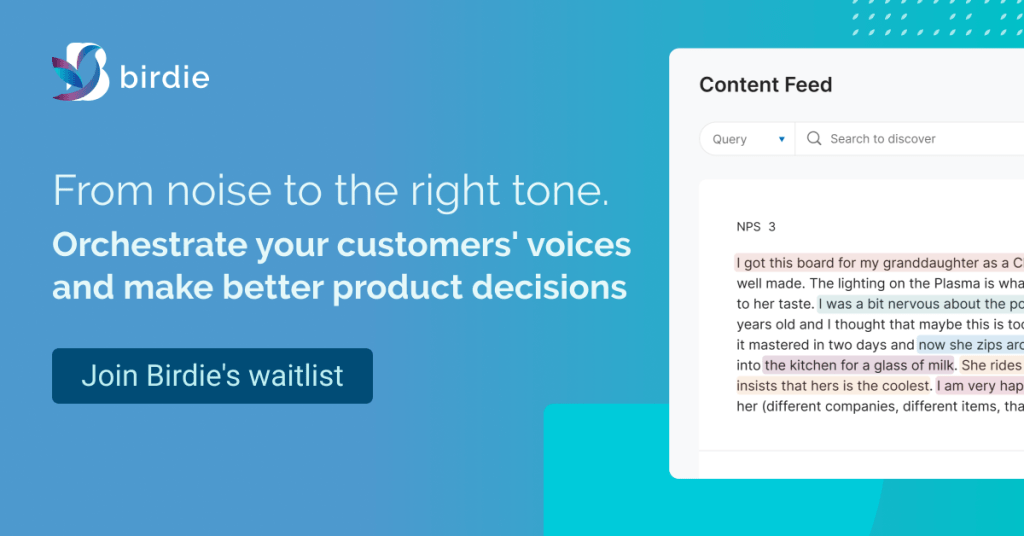
There is no doubt that direct access to consumers in the discovery process can empower product teams and help them build and launch better products. Feedback analytics can be a modern way to access these consumers compared with other traditional methodologies.
The insights generated by research studies using quantitative and qualitative approaches are essential for customer understanding. Still, at the same time, these approaches tend to be expensive and time-consuming, therefore ending up happening on an infrequent basis and less frequently than ideal. Is there something new that technology and data can bring to the table?
I deeply believe so. Even though research studies deliver amazing results and insights about customers and trends, it gives product managers less direct, firsthand exposure to the voice of their users. Instead, they rely on secondhand exposure through research reports that delivers a less nuanced understanding of who the users are and what they actually want.
When thinking about the overarching objective of listening to consumers and understanding what they expect, technology can be an ally of Product professionals, giving them tools to expose themselves to what customers are saying and asking for, with the proper context, expressing the intensity of their needs in their own words.
Feedback Analytics Tools
As we watch the acceleration of digital transformation, one key change is how we moved from a lack of data to an excess of data – or information overload, having too much information but too little tools and time to extract value from them in a helpful manner. For product teams, that means managing several different reports, feedback sources, surveys, social listening platforms, user interviews, and more – and often not using them at all.
Technology tools can be the answer to that: they can give product teams access to massive data that can revolutionize their ways of working, allowing them to explore high-quality data for a deep understanding of people’s behavior to implement an authentic customer-centric and data-driven culture.
We call these Feedback Analytics Tools. These platforms enable companies to centralize all different kinds of customer feedback in a single place. They do so by enabling access to a constant flow of data from public sources (e.g., social, web, and/or consumer data) and combining it with their own data sources (e.g., support tickets, NPS surveys, user interviews, market research, and more) to accelerate analysis, centralize all the intelligence, and make it easier for Product Leaders to come up with a continuous discovery and to collaborate with other teams to optimize their customers’ experience.
With that, they allow product teams to focus less on one-off projects and managing vendors and more on establishing a culture that generates a consistent, steady flow of insights across the organization.
The benefits of using Feedback Analytics tools for Product teams
Combining unstructured feedback data from private and public sources can help Product teams detect the issues to solve, understand what we are making right, establish a culture of agility and identify growth opportunities with a full picture of the user’s experience versus when you rely on a single source of feedback.
Access to customer feedback from support tickets, NPS surveys, customer satisfaction surveys, feature request voting tools, in-product feedback submissions, stakeholder inputs, sales loss data, churn survey, consumer reviews, social media or Reddit comments, for example, opens the possibility of understanding organically what really matters to people in their own words and the context of each channel. So Feedback Analytics tools show up as an available and effective solution to collect and consolidate consumer data.
And each source of feedback provides a unique perspective. While NPS offers a unique insight into what customers love and what are the top adoption blockers, in-product feedback submissions are great sources to understand what your most engaged users care about and discover niche use cases. While support tickets and help search queries can help teams understand what users find unintuitive, reviews can help teams understand what are the product’s key assets and liabilities versus competitors. So there’s real power in combining data sources.
Other benefits teams can get working with Feedback Analytics tools
Benefits Product Teams can get working with feedback analytics tools are:
- Understand customers over time: as data is being centralized and organized into a single platform, it makes it easier for consumer insights analysts to access historical data, something not usually possible with traditional research methods.
- Get an early-warning system: due to the real-time access to data, be able to anticipate crises or identify trends very early.
- Discover “unknown unknowns”: access to millions of spontaneous feedback allows insights teams to get unbiased and non-stimulated feedback, allowing them to learn things that they might not have thought about asking before.
- Spend time on what matters the most: focus their time on talking to customers and getting insights, and not on looking for files, reading comments, organizing spreadsheets, or such.
- Have the best of both worlds: combining user interviews or surveys with customer feedback allows product teams to get holistic insights about the customer, without the time and financial investments of robust research studies.
Feedback Analytics tools can also bring innovation to the current product development approach by helping product teams design hypotheses that could be validated on user interviews and surveys or even complement larger research studies.

More data, better insights
Working with huge amounts of data is still a challenge for some leaders who claim they cannot afford to wait as decisions must be made fast, especially when a lot needs to be cleaned to make sense. At the same time, discovery studies can take time. Using supporting technology, like feedback analytics tools, means constantly having real-time access to data and solving the time barrier.
According to MIT research, 79% of business executives want to use data to make better decisions. A better understanding of customers, better products and services, more efficient operations, reduced costs, and new business investments are some values business leaders expect to get from data strategy.
This new insight approach can help companies become data-driven, creating and developing data ecosystems capable of nurturing product teams to produce current analyses and scenarios relevant to decision-making processes.
The power of data is top-of-mind for businesses looking to succeed; the vast amount of data available can be used to transform an organization on different levels, and product teams can have a crucial role in strategizing these changes and driving innovation.
Feedback Analytics Platform for a better product strategy
Birdie helps product-centric companies better understand customers at scale to create product strategies to increase acquisition, conversion, and retention.

 Português
Português
Related Posts
HIPAA-Compliant AI for Healthcare: Secure Patient Analytics with Birdie AI
Discover how Birdie AI's HIPAA-compliant platform enables healthcare organizations to analyze patient feedback securely while [...]
How to Transform Your CX from a Cost Center to a Strategic Profit Engine
The $3.8 Trillion Problem No One’s Talking About Did you know? Companies delivering exceptional customer [...]
AI in Customer Experience: 10 Must-Read Books for 2025
Discover 2025's essential AI customer experience books, curated by feedback analytics experts. Learn how AI [...]
Driving Strategic Market Intelligence with AI-Powered Customer Feedback Analytics Tools
Discover how AI-powered customer feedback analytics tools like Birdie.ai transform market intelligence, enabling data-driven decisions [...]
The Power of Continuous Feedback Loop in CX
Learn how continuous feedback, CX-centric strategies, and actionable insights help businesses improve customer satisfaction, build [...]
Text Analytics for Voice of Customer: Beyond Topic Modeling
Discover how Birdie.ai's Areas and Opportunities model outperforms traditional topic modeling in text analytics for [...]
4 Steps to Leverage Qualitative Data to Improve Customer Satisfaction and Reduce Support Cost
After multiple iterations of our own methodology to help our customers increase their customer satisfaction [...]
Leveraging Customer Feedback Analytics to Enhance Customer Experience in FinTech
Leveraging Customer Feedback Analytics to Enhance Customer Experience